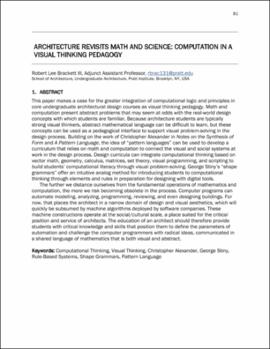| dc.contributor.author | Brackett, Robert | |
| dc.date.accessioned | 2022-03-23T20:44:52Z | |
| dc.date.available | 2022-03-23T20:44:52Z | |
| dc.date.issued | 2022 | |
| dc.identifier.citation | Brackett, Robert, "Architecture Revisits Math & Science: Computation in a Visual Thinking Pedagogy," in Person, Angela M., Anthony Cricchio, and Stephanie Z. Pilat, eds. 2022. Proceedings of Schools of Thought: Rethinking Architectural Pedagogy, Norman, Oklahoma, March 5-7, 2020. University of Oklahoma Libraries: ShareOK. | |
| dc.identifier.uri | https://hdl.handle.net/11244/335059 | |
| dc.description | This paper was presented at the 2020 Schools of Thought Conference hosted by the Christopher C. Gibbs College of Architecture at the University of Oklahoma. | |
| dc.description.abstract | This paper makes a case for the greater integration of computational logic and principles in core undergraduate architectural design courses as visual thinking pedagogy. Math and computation present abstract problems that may seem at odds with the real-world design concepts with which students are familiar. Because architecture students are typically strong visual thinkers, abstract mathematical language can be difficult to learn, but these concepts can be used as a pedagogical interface to support visual problem-solving in the design process. Building on the work of Christopher Alexander in Notes on the Synthesis of Form and A Pattern Language, the idea of “pattern languages” can be used to develop a curriculum that relies on math and computation to connect the visual and social systems at work in the design process. Design curricula can integrate computational thinking based on vector math, geometry, calculus, matrices, set theory, visual programming, and scripting to build students’ computational literacy through visual problem-solving. George Stiny’s “shape grammars” offer an intuitive analog method for introducing students to computational thinking through elements and rules in preparation for designing with digital tools. The further we distance ourselves from the fundamental operations of mathematics and computation, the more we risk becoming obsolete in the process. Computer programs can automate modeling, analyzing, programming, reviewing, and even designing buildings. For now, that places the architect in a narrow domain of design and visual aesthetics, which will quickly be subsumed by machine algorithms deployed by software companies. These machine constructions operate at the social/cultural scale, a place suited for the critical position and service of architects. The education of an architect should therefore provide students with critical knowledge and skills that position them to define the parameters of automation and challenge the computer programmers with radical ideas, communicated in a shared language of mathematics that is both visual and abstract. | |
| dc.language.iso | en_US | |
| dc.relation.ispartof | 2020 Schools of Thought Conference | |
| dc.relation.uri | https://hdl.handle.net/11244/335058 | |
| dc.rights | CC BY-NC-SA | |
| dc.rights.uri | https://creativecommons.org/licenses/by-nc-sa/4.0/ | |
| dc.subject | computational thinking | |
| dc.subject | visual thinking | |
| dc.subject | Christopher Alexander | |
| dc.subject | George Stiny | |
| dc.subject | rule-based systems | |
| dc.subject | shape grammars | |
| dc.subject | pattern language | |
| dc.subject | architectural education | |
| dc.title | Architecture Revisits Math & Science: Computation in a Visual Thinking Pedagogy | |
| dc.type | Article | |
| dc.description.peerreview | Yes | |
| dc.identifier.doi | 10.15763/11244/335059 | |
| ou.group | Christopher C. Gibbs College of Architecture | |


